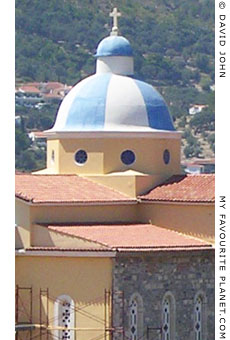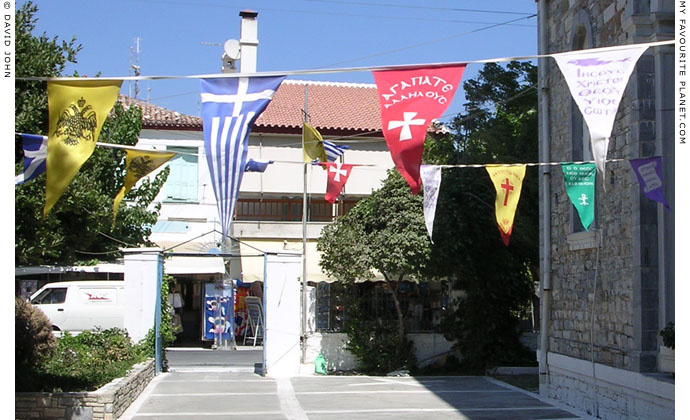|
|
|
| My Favourite Planet > English > Europe > Greece > Northern Aegean > Samos > gallery |
| Samos, Greece |
Samos gallery |
 |
 |
50 of 55 |
 |
 |
|
| |

Agios Nikolaos Church in Kokkari, Samos. |
| |
In the left of the photo is part of the small coastal plain on which Kokkari stands. Land is at a premium, and olive and fruit trees are gradually losing ground to new houses and hotels. In the background are the steep, pine-forested hills below the lower slopes of Mount Ambelos (see gallery page 43).
Agios Nikolaos Church (Άγιος Νικόλαος Κοκκαρίου) has an area of 650 square metres, and is 44 metres tall, if you include the cross on top of the dome. It is the largest church and by far (so far) the largest building in Kokkari, towering above the other buildings. It also claims to be the sixth largest church in Greece and third largest in the Aegean. Built in the form of a rectangular basilica with an apse at the east end, its single dome rests on an octagonal drum, each face of which has a round window.
Like many other churches on Samos, part of the plain stone exterior has been painted in bright colours, and the dome is decorated with typically Samian blue and white vertical stripes.
The dedication of the church to Agios Nikolaos follows the Greek tradition of churches at harbours and near the sea named after the patron saint of sailors and fishermen (see Kastellorizo gallery, page 99). |
|

The dome of
Agios Nikolaos Church |
|
| |
The building of the Agios Nikolaos Church began in 1902 when Samos was still under Ottoman Turkish control as a semi-autonomous principality, ruled by Prince Alexander Mavrogenous (Ἀλέξανδρος Μαυρογένους, 1845-1929, ruled 1902-1904).
The intiative was led by the Metropolitan of Samos, Athanasios Kapouralis (Μητροπολίτη Σάμου Αθανάσιος Καπουράλης) and Kokkari's mayor, Photios Frangoulis Garoufalis (Φωτίος Φραγκούλης Γαρουφαλης). The money required for the construction was raised by a lottery set up with the permission of the prince and the Turkish authorities, and Angelos Angelidis (Άγγελος Αγγελίδης), who also designed churches in Vathy and Karlovasi [1], was appointed as architect.
It seems strange that the inhabitants of Kokkari decided to build such an enormous, expensive church in their small village. The present population is around 1,060 (according to the 2011 census), and must have been much smaller at the beginning of the 20th century. The building appears out of proportion to the villagers' needs, and one can only speculate that the church was planned as a status symbol for Kokkari and Samos, and as a defiant assertion of Orthodox Christianity on the island. This was the age when Christian denominations worldwide were building huge churches and cathedrals (see, for example Anglican Cathedral in Liverpool, started 1904, completed 1978, at The Cheshire Cat Blog, February-March 2011).
The expensive building project ran into financial difficulties when permission to issue lottery tickets was withdrawn by Prince Andreas Kopasis (Ανδρέας Κοπάσης 1856-1912, ruled 1908-1912 [2]) in 1908. Construction was halted, and the church remained unfinished for 25 years.
Following the independence of Samos in 1912, when the island became part of the modern Greek state, the wealthy Kokkarian Ioannis Elissavitis (Ιωάννης Ελισσαβίτης) offered to finance the completion of the church, and construction work resumed in 1933. Since the architect Angelos Angelidis had meanwhile died, the continuation of the work was supervised by the engineer P. Hatzikonstantis (Π. Χατζηκωνσταντής). Although the building was completed in 1938 and used for services, it was not officially consecrated until 8th December 1963 by the Metropolitan of Samos and Ikaria, Paronaxia Epiphanios (Παροναξίας Επιφάνιο). |
|

Agios Nikolaos Church towers above Kokkari rooftops. |
|
| |

Festive bunting in the churchyard of Agios Nikolaos Church, Kokkari.
|
The colourful pennants fluttering in the wind in the churchyard of Agios Nikolaos Church include the Greek flag and Christian symbols such as the fish and crosses in various forms.
Yellow pennants show the double-headed eagle, the symbol of the Byzantine Empire and the Greek Orthodox Church (Ελληνορθόδοξη Εκκλησία). Although the Byzantine Empire ceased to exist after the fall of Constantinople in 1453, the Church's primate, the Ecumenical Patriarch of Constantinople, still resides in the city (now known as Istanbul) considered by Church members as the historical, spiritual and symbolic centre of their religion.
Other Samos churches featured in this gallery:
Church of the Transfiguration, Castle of Logothetis, Pythagorio
Panagia Spiliani Monastery, Pythagorio
Churches and belltowers in Chora
Kimisi Theotokou Church (Dormition), Kokkari
Kimisi Theotokou Church (Dormition), Karlovasi
Agios Nikolaos Church, Karlovasi |
|

Byzantine / Greek Orthodox
pennant at Agios Nikolaos. |
|
| |

Religious pennants in the churchyard of Agios Nikolaos Church, Kokkari. |
| |
| Samos |
Notes, references and links |
 |
|
1. Architect Angelos Angelidis
Angelos Angelidis (Άγγελος Αγγελίδης), architect of the Agios Nikolaos Church in Kokkari, also designed the Agios Spyridon Church in Vathy, as well as the Dormition and Agios Nikolaos churches in Karlovasi. An Angelos Angelidis is credited with designing the Neoclassical Archaeological Museum of Volos, built in 1909, although we have so far been unable to find further information about this or the architect himself. One source states that he was from Karlovasi.
2. Prince Andreas Kopasis
Prince Andreas Kopasis (Ανδρέας Κοπάσης 1856-1912, ruled 1908-1912), was the penultimate Turkish-appointed Prince of Samos before a Greek force took the island in 1912 and declared it independent and part of Greece (see gallery page 13). Kopasis was deeply unpopular and considered by the islanders to be tyrannical. Popular uprisings forced him to call for military assistance from the Turkish authorities in May 1908, which led to the death of many islanders. He was assassinated in March 1912 by pro-independence Samians. |
|
|
Photos, maps and articles: © David John 2003-2019,
except where otherwise specified.
All photos and articles are copyright protected.
Images and materials by other authors
have been attributed where applicable.
Please do not use these photos or articles without permission.
If you are interested in using any of the photos for your website,
publication or project, please get in contact.
Higher resolution versions are available on request.
Some of the information and photos in this guide to Samos
originally appeared in 2003-2004 on davidjohnberlin.de.
My Favourite Planet makes great efforts to provide
comprehensive and accurate information across this website.
However, we can take no responsibility for inaccuracies or changes
made by providers of services mentioned on these pages. |
| |
 |
Visit the My Favourite Planet Group on Facebook.
Join the group, write a message or comment,
post photos and videos, start a discussion... |
|
|
| |
|
|
| |
| |
 |
| |
 |
| |
 |
| |
 |
| |
 |
| |
 |
| |
George Alvanos
rooms in
Kavala's historic Panagia District
Anthemiou 35,
Kavala, Greece
kavalarooms.gr
|
| |
Olive Garden Restaurant
Kastellorizo,
Greece
+30 22460 49 109
kastellorizo.de
|
| |
Papoutsis
Travel Agency
Kastellorizo,
Greece
+30 22460 49 286
greeklodgings.gr
|
| |
|